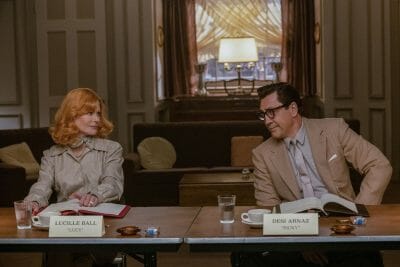
Being the Ricardos | Behind the Scene of Show Business
Year
Runtime
Director
Writer
Cinematographer
Production Designer
Music by
Country
Format
Genre
Subgenre
In September 1953, Lucille Ball, beloved American star of the landmark sitcom I Love Lucy (1951-1957), received charged with being a Communist. And it is exactly to Ball and her show’s colossal legacy that screenwriter and director Aaron Sorkin (The Trial of the Chicago 7) paid tribute in Being the Ricardos. Not only a homage but also an attempt to shed light on one of Hollywood’s most iconic couples – that of Lucille Ball and Desi Arnaz – trying to balance their public and private lives. Being the Ricardos is an unconventional biopic about life in show business at the time of the Red Scare. When Hollywood, and post-war America were on the receiving end of an often-paranoid governmental fear of Communist influence and infiltration.
Right from its opening, Sorkin makes it clear that Being the Ricardos will be nothing standard. The biopic genre already appears tainted before the first scene, when the sound of people laughing fills the black screen, immediately recalling the sitcom genre. Soon after, I Love Lucy‘s showrunner Jess Oppenheimer (John Rubinstein) talks while looking directly into the camera. His interview, along with those of the show’s lead writers, not only introduces the movie as a mockumentary but immediately presents the story as an account of just one very demanding week.
So, multiple genres and narrative styles mix to craft an original tale about a more well-known piece of American pop culture history.Being the Ricardos earned three nominations at the 94th Academy Awards: Best Actress for Nicole Kidman; Best Actor for Javier Bardem; and Best Supporting Actor for J. K. Simmons. Additionally, for her portrayal of Lucille Ball, Kidman received the Golden Globe for Best Actress – Drama at the 79th Golden Globe Awards.
All during a tough week
Lucille Ball (Nicole Kidman) and her husband Desi Arnaz (Javier Bardem), work as co-stars on the sitcom I Love Lucy. They share the set with actress Vivian Vance (Nina Arianda) and actor William Frawley (J. K. Simmons) and the show is a huge success. That is until the day everything breaks down: Desi is photographed with another woman and Lucille is accused of being a Communist. As if that were not enough, Lucille discovers she is pregnant and producers are not too happy about the news. Far from agreeing to hide her condition, Lucille aspires to revolutionize the world of entertainment.
The narration follows three different time perspectives. The first one, set in the present, shows interviews with the head writers and I Love Lucy‘s showrunner; the second one follows the preparation process for the live shoots and the days of the scandals; while the third one consists of flashbacks to Lucille and Desi’s past. The interviews build a frame narrative, creating a fake documentary about a true story. A detail that makes the movie different from mockumentaries such as Jemaine Clement and Taika Waititi‘s What We Do in the Shadows (2014) or Woody Allen‘s Zelig (1983).
Also crucial is the use of meta-cinema. The story repeatedly carries the viewer in and out of the production and creative process, as it occurs in the Italian niche tv-series Boris (2007). As Sorkin told The Hollywood Reporter, this shift between show and reality allowed him to explore Lucille as a person more than as an actress.
I Love Lucy: a milestone
CBS aired the first episode of I Love Lucy on the 15th of October 1951. The show was an adaptation of the radio show My Favorite Husband, which featured Lucille Ball as the female protagonist. When she was asked to bring Lucy to the screen, she made it a condition that her husband would co-star. Despite the doubts, the producers could only agree, resulting in a sitcom that still boasts many records and has influenced all subsequent productions in the genre, even receiving homages from many series, including Will & Grace.
I Love Lucy became the first sitcom to be shot on 35 mm film in front of a studio audience. The use of three cameras at the same time gave the possibility of dynamic editing. In addition, it was the first show featuring an ensemble cast and producing a Christmas special. The content was also revolutionary: Lucille Ball became the first woman to appear pregnant on one of the three major television networks. Today, I Love Lucy is universally considered one of the greatest sitcoms in television history.
Not the usual biopic
Sorkin has already had a lot of experience with the biopic genre and movies based on real events. Indeed, he wrote the screenplays for Charlie Wilson’s War (2007); The Social Network (2010), for which he won the Academy Award for Best Adapted Screenplay; and Steve Jobs (2015). His first movie as a director, Molly’s Game (2017), is also a biographical drama. In his hands, biographies become mythological tales and single characters symbolize the whole of humanity. But more than that, for Sorkin a single life is often a chance to shine a light on one aspect of America and its history.
But Being the Ricardos is not the usual biopic that simply creates a portrait of an immortal character. Lucille remains in the spotlight, but every detail of her life is functional to show the context. Her physical comedy, as well as her ability to foreshadow gags and whether they will work, don’t just display her brilliant mind. They also help illustrate how I Love Lucy shaped subsequent television production.
The careful opposition between comedy and drama underscores the story’s two sides. On the one hand, Being the Ricardos is a retread of a sitcom and four brilliant comedians; but on the other, it is an intense drama about a real couple with real problems. This balance mirrors the antithesis between fictional characters and real people; life on screen and life behind the screen.

Who is Lucille Ball?
Sorkin’s choices regarding the main cast received criticism. Kidman, in particular, appeared not so similar to the original Lucy, and the makeup artists even used prosthetics to make her look like the character. While Bardem was questioned because of his Spanish origins, as he plays a Cuban in the movie. But Sorkin did not doubt his choice for a moment.
In the end, Sorkin and Kidman portray Lucille in great detail. Following the actress during the week leading up to the airing, they give a glimpse into the care she used to put in preparing each episode. Indeed, the movie shows how Lucille was present during all steps of production, even giving her opinions on writing and directing. By showing what goes on behind the scenes, Being the Ricardos gives insight into how meticulous and even obsessive Lucille was. Even though her character faces far-fetched situations, she always tries to find logical solutions and explanations for what she does
When most people think of Lucille Ball and Desi Arnaz, they’re thinking of Lucy and Ricky. But Lucille Ball was more of a Rita Hayworth, Jessica Rabbit-looking actress.
Director Aaron Sorkin in an interview with The Hollywood Reporter
Espionage, censorship, and terror
The three events that shake Lucille and Desi reflect more broadly social and production realities. From the denunciation of how deeply the Motion Picture Production Code (known as the Hays Code) has affected the entertainment industry; to the obsession with espionage; to the Red Scare in Hollywood.

Notably, the Hays Code laid down the law of self-censorship in Hollywood until 1968. Under the Hays Code, nothing that was considered immoral could be filmed. Even pregnancy was considered an allusion to sex, and therefore a “perversion”. When Lucille announces that she is expecting a baby, however, there is one other thing that stands out: she is the only woman in the production studio. A scene that somehow denounces how bigoted and pervaded with machismo the Hollywood production system was. But also an anchor to the social-political battles that have hit the cinematic industry in recent years.
Form & Content
With Being the Ricardos Sorkin establishes an ongoing dialogue with the viewer. Mock interviews, meta-cinema, and the behind-the-scenes look create direct involvement. In addition, the movie reveals an exact cross-section of the creative and production process. Writers, producers, set designers, and editors, figures usually invisible to the outside world, come to the forefront.
The movie’s structure also influences its contents. The opposition between reality and fiction, made evident by the alternation between the show and its preparation, becomes the movie’s leitmotif. The mockumentary style enlightens the inner clockworks of the dream industry, shedding light on its negative aspects: a cold industry that cares more about profits and hides everything else under a golden veil.

When Lucille announces her pregnancy, no one cares about anything other than what it means for the show. Instead, Sorkin emphasizes the Ricardos’ life as a couple, both on-screen and in reality. He highlights how their bond helped them get through the most difficult week of their careers.
In conclusion, with Being the Ricardos, Aaron Sorkin also unveils how the show business used to work, pointing out how something is still resistant to change today. And as golden as the dream machine may seem, it’s not so easy to survive in it.
Tag
Buy a ☕ for Hypercritic









